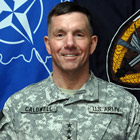"a soldier interacting, without mediation"


Leadership
Kairos: We've asked to interview you for this special issue of Kairos because of several roles you've held: first, in your role as spokesperson for the Multi-National Force—Iraq (MNF-I); later, as commander of the Combined Arms Center (CAC), where you held oversight and responsibility for the development of doctrine, education, development of doctrine, and training for the Army; and currently as commander of the National Training Mission (NTM-A) and Combined Security Transition Command—Afghanistan (CSTC-A). In your emphasis on strategic communications in all these roles, in the importance you place upon education and training, and in your attention to the role of new media and digital communications technologies, you engage the three domains Kairos focuses on: rhetoric, technology, and pedagogy. From the roles you've held, what are the most important lessons you'd want to pass along about the effective uses of rhetoric, technology, and pedagogy?
Lt. Gen Caldwell: What I know is that we, the US military, have to share our story with not only the American public, but also with the international community. When I was in Iraq as the spokesperson and Director of Strategic Effects for Multi-national Forces-Iraq, I experienced firsthand the need for the coalition forces to tell their story and the power of the media to help tell that story. What we do each day can affect millions of lives. That means we have to educate people about what we do and inform them about what we are doing. It is the best way to maintain support and understanding with the people we serve. Social media is a vital part of that. I just read a Pew survey the other day that said 74% of adults use the Internet and that overall Internet usage has increased 25% in the last nine years. That alone tells me that the Internet and all it has to offer are essential for getting out information. That is why I worked with the command in Iraq to lift the ban on blogging and the use of YouTube in 2006. That is why I was so excited to get a command blog and website going at the Combined Arms Center, at Fort Leavenworth, Kansas, in 2008, and why I am even more pleased with the NATO Training Mission-Afghanistan website that was just brought up last month. It has news stories, tweets, a blog, Flickr, and YouTube. It is great. You can learn about NTM-A and what we are doing every day with the Afghan National Security forces, all in one place. It is a resource for anyone who wants to know and learn more about training Afghan National Security Forces.
Kairos: In your blogging, tweeting, and maintaining a YouTube site, do you see yourself as providing a model for other military leaders to emulate? How influential has your Internet presence been?
Lt. Gen Caldwell: Understanding the power of a tweet, the influence of a blog post, or the impact of a YouTube video is absolutely essential for leaders in the military. It is an opportunity to talk directly to people, without mediation. It is what I am thinking, and what I want to say, in my own words. This kind of direct connection with an audience emphasizes two things I value: transparency and credibility—transparency in all I do or all my command does, which in turn increases credibility. If you know who I am and what I'm about, if you know our challenges and successes with training and developing Afghan Security Forces, when you know you have an honest broker, you are going to be more apt to listen.
The ability for individuals to connect with a large audience through the media and social media to share their story is why I implemented a change to the curriculum at the Command and General Staff College (where all mid-level officers go to further their professional education) when I was the Commandant. Information engagement assignments were added to the syllabi to introduce and emphasize the power of interacting with the public. All students were required to post a blog, write an article for publication, participate in a media interview, and speak in a public venue. By increasing the awareness of all these different modes of communication, the US Army hoped to begin growing leaders that will harness the power of a blog, or YouTube, or the Internet to make the Army more successful in all that it does from Haiti to Afghanistan.